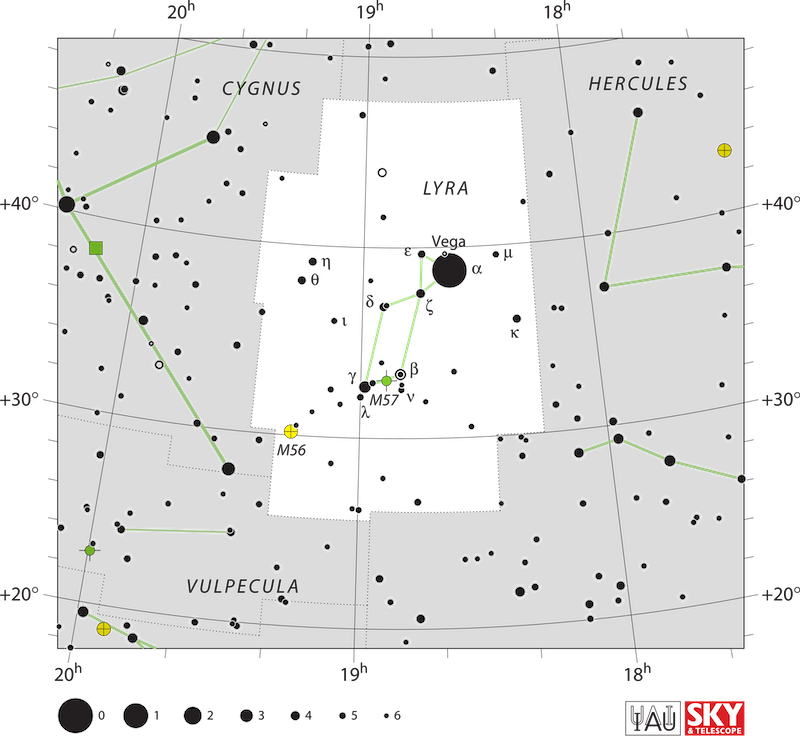

A photo of Epsilon Lyrae, the Double-Double star in the constellation Lyra the Harp. See how each component in this double star system is also 2 stars? Image via Nikolay Nikolov/ Wikimedia Commons.
Epsilon Lyrae (ε Lyrae), also known as the Double-Double star, is easy to locate due to its nearness to Vega, the brightest star in the northern half of the sky. Through binoculars, what appears as one star to the unaided eye resolves into two. And through a telescope, each star in that pair resolves into two again, making four stars. In the mid-1980s, astronomers using advanced imaging techniques detected a fifth star in that system. These five stars, bound together by gravity, are about 162 light-years from us. Read more.
How to find Epsilon Lyrae. Epsilon Lyrae is wonderfully easy to find. It’s not as bright as Vega, the constellation Lyra’s brightest star.
But Vega’s brightness, plus the distinctive shape of the constellation Lyra, can help you spot Epsilon Lyrae.

A star map of Lyra showing its primary stars. Vega is represented by the large black circle, indicating its brightness relative to other stars. Epsilon Lyrae is close to it, designated by the Greek letter “epsilon” (ε). Image via IAU/ Sky & Telescope / Wikipedia.
With the eye, the gap between Vega and Epsilon Lyrae only amounts to the width of your little finger at an arm length away. As a fun bonus, you can see Vega and Epsilon Lyrae in a single binocular field.
You might also find Vega by looking for the brightest star in the famous Summer Triangle asterism. Just remember, Epsilon Lyrae, though not as bright as Vega, shines near this brighter beacon star.
From mid-northern latitudes, Epsilon Lyrae and its constellation Lyra the Harp shine for at least part of the night all year round. Epsilon Lyrae graces the nighttime from dusk until dawn on Northern Hemisphere summer nights. It’s high overhead on northern autumn evenings. In northern winter, this star appears both in the northwest sky after dusk, and then in the northeast sky before dawn. When northern spring arrives in March, Epsilon Lyrae rises before midnight, then shines for rest of the night.
Science of the Double-Double star. Although Vega and Epsilon Lyrae appear close together in the sky, they really aren’t. They simply appear that way along our line of sight. Astronomers have determined that Vega is some 25 light-years away, whereas Epsilon Lyrae is over six times farther, at about 162 light-years.
There are many multiple star systems in the sky, but Epsilon Lyrae is special because it’s so easy to find, and so satisfying to observe when it resolves as a double star through binoculars and as a pair of binary stars through a telescope.
While the widest two components of the Epsilon Lyrae system can be clearly viewed with binoculars, you may be able to barely discern them with the unaided eye under excellent sky conditions. The northern star of the pair is known as Epsilon 1 while the southern star is Epsilon 2. They’re thought to be about 10,500 times the sun-Earth distance apart and probably take over hundreds of thousands of years to orbit each other.
Through a telescope, Epsilon 1 and Epsilon 2 are revealed to be double stars. Here, Tom Kerrs posted an image on Twitter showing Epsilon 1 and Epsilon 2 resolved as binary stars.
Epsilon Lyrae (? Lyr) – the "Double Double". It's also a binary binary. In fact, one pair has a third companion, too! pic.twitter.com/j9mJs9K8oi
— Tom Kerss ??? (@tomkerss) October 3, 2015
https://platform.twitter.com/widgets.js
Epsilon 1 has two components, designated A and B, separated by about 116 times the sun-Earth distance with an orbital period of about 1,800 years. Epsilon 1A is a hot star about twice the mass of the sun and Epsilon 1B is a bit cooler, about 1.6 times the sun’s mass.
Epsilon 2 has three components: the two stars visible through a telescope are hot stars about twice the mass of the sun, separated by about 121 times the sun-Earth distance, with an orbital period of about 724 years. The third star is so faint that it was only detectable using an advanced imaging technique known as speckle imaging, and not much is known about it
Epsilon Lyrae 1 is at RA: 18h 44m 20.3s, Dec: +39° 40′ 12.4″
Epsilon Lyrae 2 is at RA: 18h 44m 22.8s, Dec: +39° 36′ 45.8″

Image via daviddarling.info.
Bottom line: Epsilon Lyrae, near Vega in the constellation Lyra, is known as the Double-Double star because it appears as two stars through binoculars, and each of those are further resolved into two stars through a telescope.
Source:
https://earthsky.org/brightest-stars/epsilon-lyrae-the-famous-double-double-star